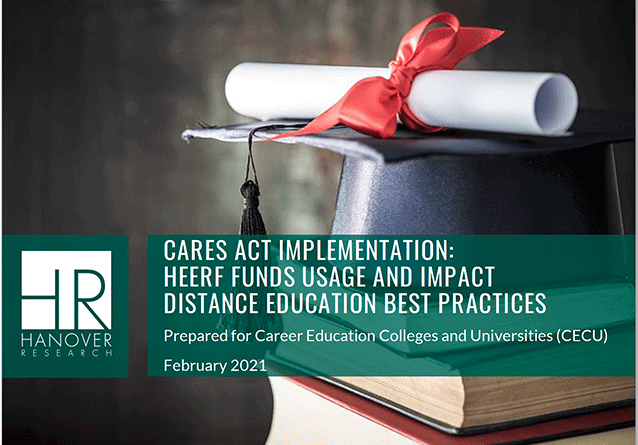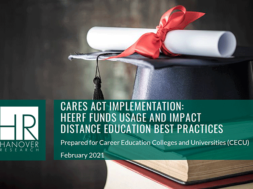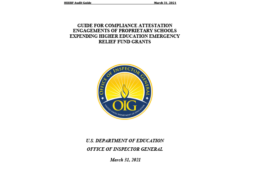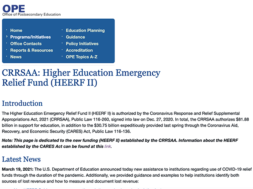
CARES Act Implementation: HEERF Funds Usage and Impact & Distance Education Best Practices
By Hanover Research, prepared for Career Education Colleges and Universities (CECU)
Higher Education Emergency Relief Funds had a positive impact on instruction, the student experience and student success, according to a Hanover Research report prepared for Career Education Colleges and Universities, or CECU.
About 263 leaders of career and technical colleges from 42 states responded to an online survey inquiring about their experience with HEERF money provided by the CARES Act in December 2020. According to the survey:
- 84% of respondents said HEERF funds had or will have a somewhat or extremely positive impact on students’ ability to attend class
- 81% reported that HEERF funds had or will have a somewhat or extremely positive impact on students’ ability to complete assignments and instructor ability to teach effectively
- 79% of respondents reported a positive impact on student engagement with course materials
- 78% reported a positive impact on students’ ability to balance work and education
- 76% said the funds positively impacted students’ ability to balance family responsibilities and education, and
- 75% said HEERF increased accessibility to campus resources.
As of Nov. 1, 2020, 54% of respondents said their institution had spent 51% or more of its overall HEERF money on emergency financial aid grants for students when only 50% was mandated. In fact, 36% of respondents indicated their institutions allocated more than 70% to emergency financial aid grants for students.
Of those schools with remaining funds, the majority reported less than 50% left to allocate, with respondents citing the ongoing nature of the pandemic and the school taking a conservative approach to students’ future needs as common reasons for the unallocated funds.
The most common uses for the remaining institutional portion of the funds were personal protective equipment, or PPE, at 82%; facilities improvement including sanitation, also at 82%; and information technology equipment or software to facilitate distance learning at 81%. Faculty salaries, particularly those not related to distance education, was one of the least allocated expenses for the remaining institutional funds at 11%.
Overwhelmingly, respondents believed that additional funding for higher education institutions should be allocated to both student and institutional needs.
About 12% indicated funds should be directed just toward student needs. However, only 4% indicated the same for just institutional needs.
The survey found that 48% of respondents used financial reserves and 46% reorganized existing budgets to finance the instant transition to distance learning in March 2020. In addition, 29% reported using HEERF money as a main source of financing the immediate transition to distance learning. However, 76% of respondents used HEERF to improve the academic quality of its distance education programs and 83% used the funds to improve its distance education technology, the survey showed.
Participants also overwhelmingly indicated that HEERF money has, had or will have a somewhat or strongly positive impact on almost all aspects of distance learning. If more HEERF money was available, participants noted they would use the additional funds to further improve distance education programs:
- 69% reported they would be increasing faculty training for delivering online instruction
- 61% said they would increase the use of technology for clinical/lab experiences
- 60% reported they would improve the quality of education technology, as well as improve tech support for students in online programs
In addition, 59% of the respondents said their institutions will continue to offer distance education after the pandemic ends and 85% will do so by offering a mix of distance, in-person and hybrid programs.
Best practices for distance education
In September 2020, Hanover Research conducted in-depth interviews with 15 leaders of career and technical colleges. Respondents represented small, medium and large institutions in 14 states throughout the United States. The schools offered programming in a wide variety of areas including HVAC, legal, business, IT, graphic arts, nursing, allied healthcare, healthcare technology and culinary.
According to participants, the immediate halt to in-person, classroom-based experiential learning and externships was the biggest challenge career education schools experienced as the pandemic forced schools to physically close their classrooms. The need for intensive faculty training was an additional challenge, particularly in traditionally hands-on and lab-based programs.
According to the report, all programming that could be transitioned to distance education was moved together. Not surprisingly, delays were experienced for components of programs that require skill development through hands-on work in labs or externships, for which schools needed additional planning time, including HVAC, allied healthcare, cosmetology, massage and nursing.
One of the most significant challenges schools encountered was how to address required externship/clinical experience, particularly for healthcare programs.
Campuses shut down labs, and healthcare facilities halted students coming in for clinicals. Because access to facilities is dependent on state and local guidance and need, some schools have experienced a backlog of students who are behind on earning required hours.
In addition, some students did not have the technology they needed for online courses and schools needed to provide them equipment. An initial surge in need for technology created potential issues with timely access to equipment. A minority of students were unable to successfully make the transition to distance learning and took a leave of absence from schools. While others have stayed in the program, they have voiced frustrations about not being able to return to campus.
Key findings from the interviews showed:
- The transition to distance education was made within a week at the onset of COVID-19. All programming possible was moved immediately to an online platform with little disruption to classes.
- Schools took an immediate response to front-load all theory-based content, putting in-person requirements on hold. Schools leveraged relaxed federal, state and accreditor rules to institute simulation software and put students who needed it on temporary leaves of absence.
- The biggest challenge career education schools experienced was the immediate halt to in-person, classroom-based experiential learning and externship. Additional challenges included the need for intensive faculty training and supporting student transitions.
- Schools reported that academic outcomes have been at or above typical levels. Researchers found that students commonly adapted to the transition to distance education with ease and enthusiasm. They attributed that to the maturity and resourcefulness of career education students, who are often older than traditional students. In addition, schools are proud that, despite challenges encountered with labs and clinicals, graduation rates have been maintained at the levels of previous years.
- A robust Learning Management System (LMS) is essential for long-term distance education plans. The LMS provides the increased structure an online program requires and offers capabilities Zoom does not have.
- Schools plan to maintain remote learning that was instituted in the spring of 2020 until early 2021, when they will re-evaluate the local situation and the extent to which they can re-open campuses. In-person labs have been re-initiated with safety protocols in place alongside continued use of simulations.
- Successful experiences with distance education have prompted schools to consider incorporating online learning into permanent offerings by their school.
However, ensuring the quality of distance education will be essential for those schools that continue with virtual learning. According to Hanover, key factors include:
- Faculty engagement: Training for faculty is essential for online delivery. Schools with robust online programs have specialized teams dedicated to ongoing faculty training and curriculum design. During the pandemic, most instructors acclimated to the change with support, with a small minority being unable to adjust to the transition.
- Student engagement: Career education students are often nontraditional learners who need targeted services. Comprehensive onboarding to ensure online proficiency, career and academic advising and retention monitoring helps to ensure student success.
- Robust infrastructure: A LMS is needed to provide increased structure an online program requires and offers capabilities Zoom does not have. Shells for each class uploaded to a LMS include assignments, message boards, virtual lab materials and more.
- Flexible models: COVID-19 amplified the need for flexibility in operating online programs and offers an opportunity to change typical teaching models. For example, one instructor can teach all lecture sections while another teaches all labs. This aligns with the flexibility provided by new federal regulations aiming to make instructional teams easier to implement.
Overall, the study showed that given the gravity and level of unknown the pandemic caused, faculty and staff went above and beyond to ensure student needs were consistently met and faculty received the training and resources they needed. For the full report visit https://www.career.org/.



